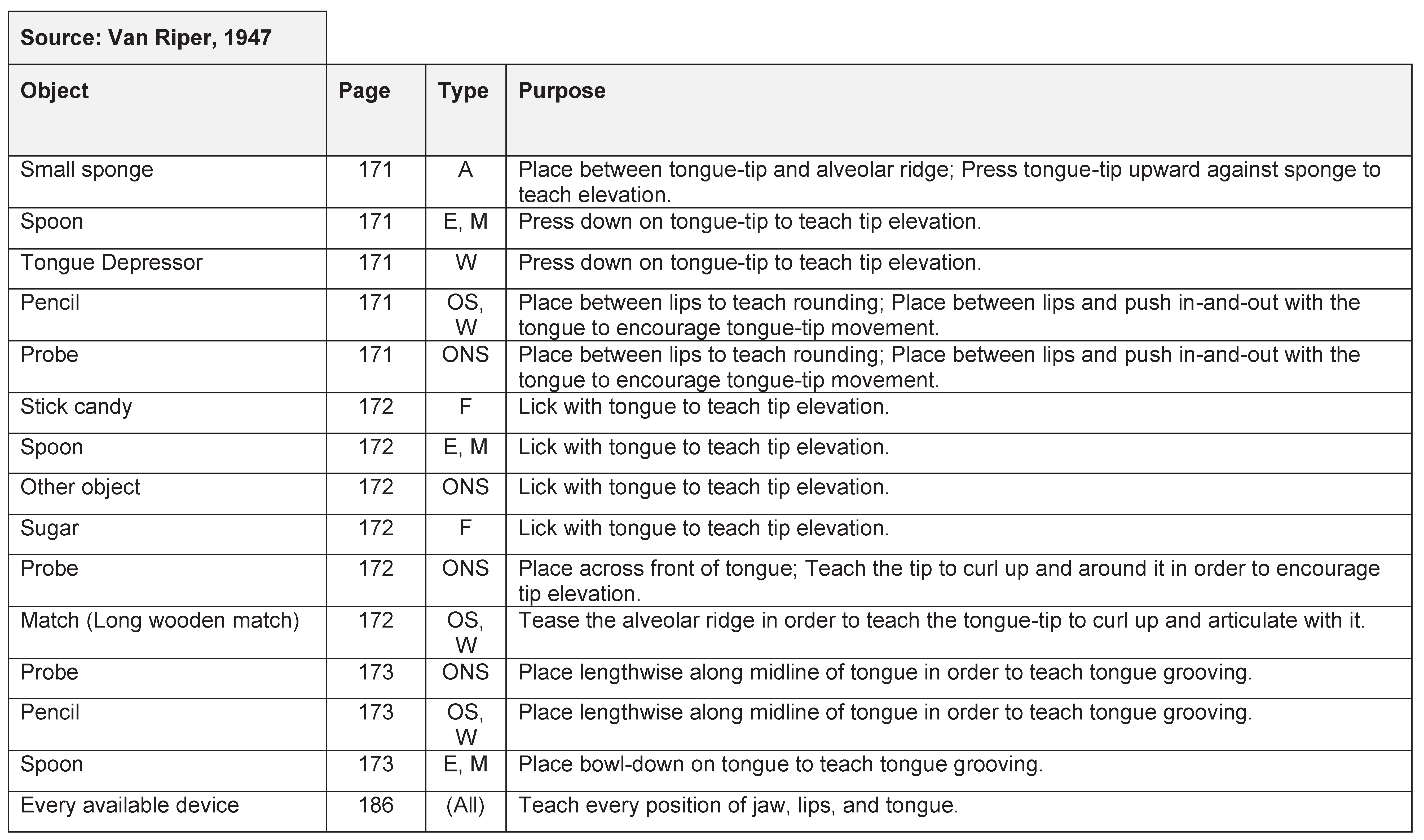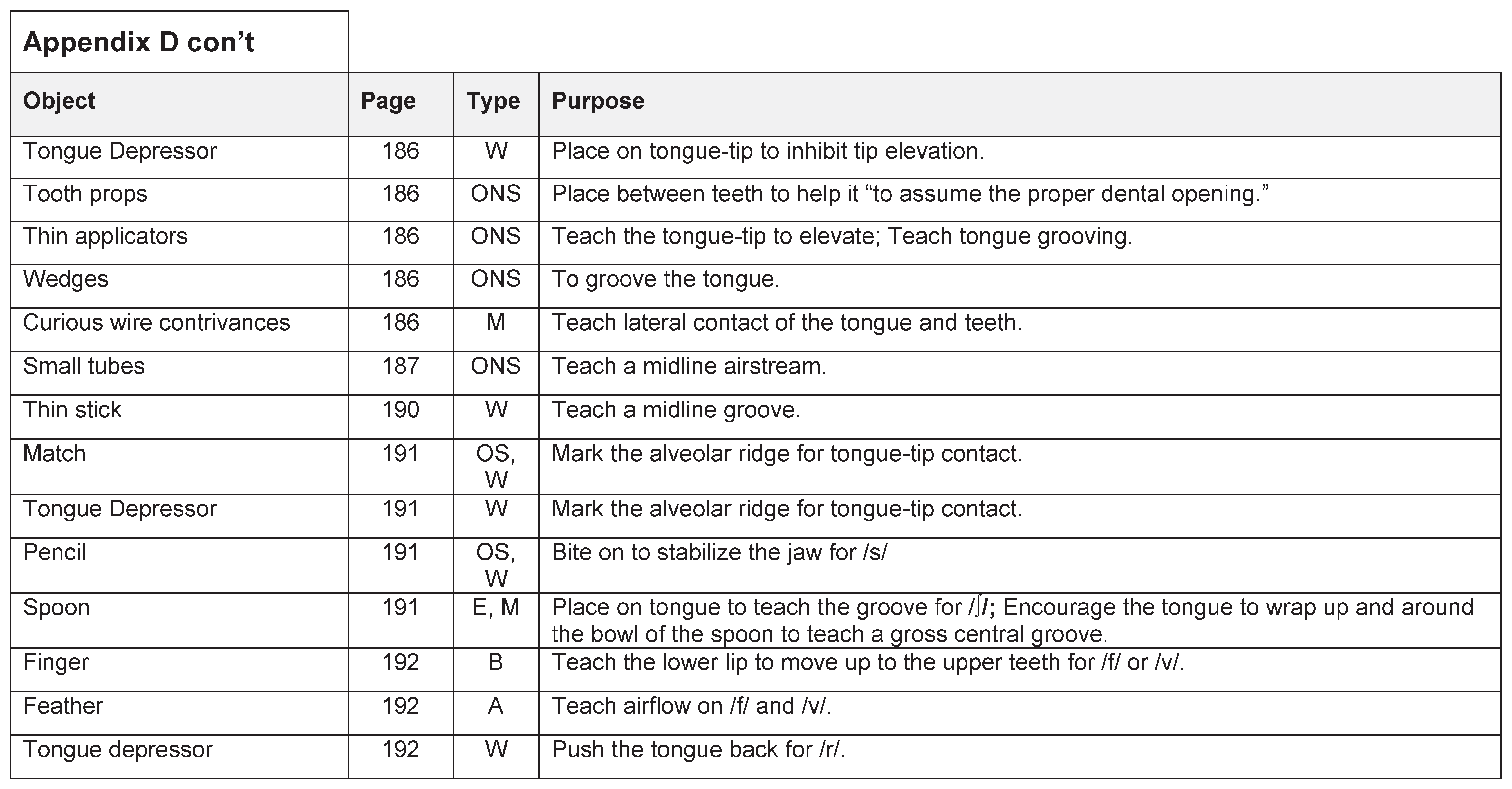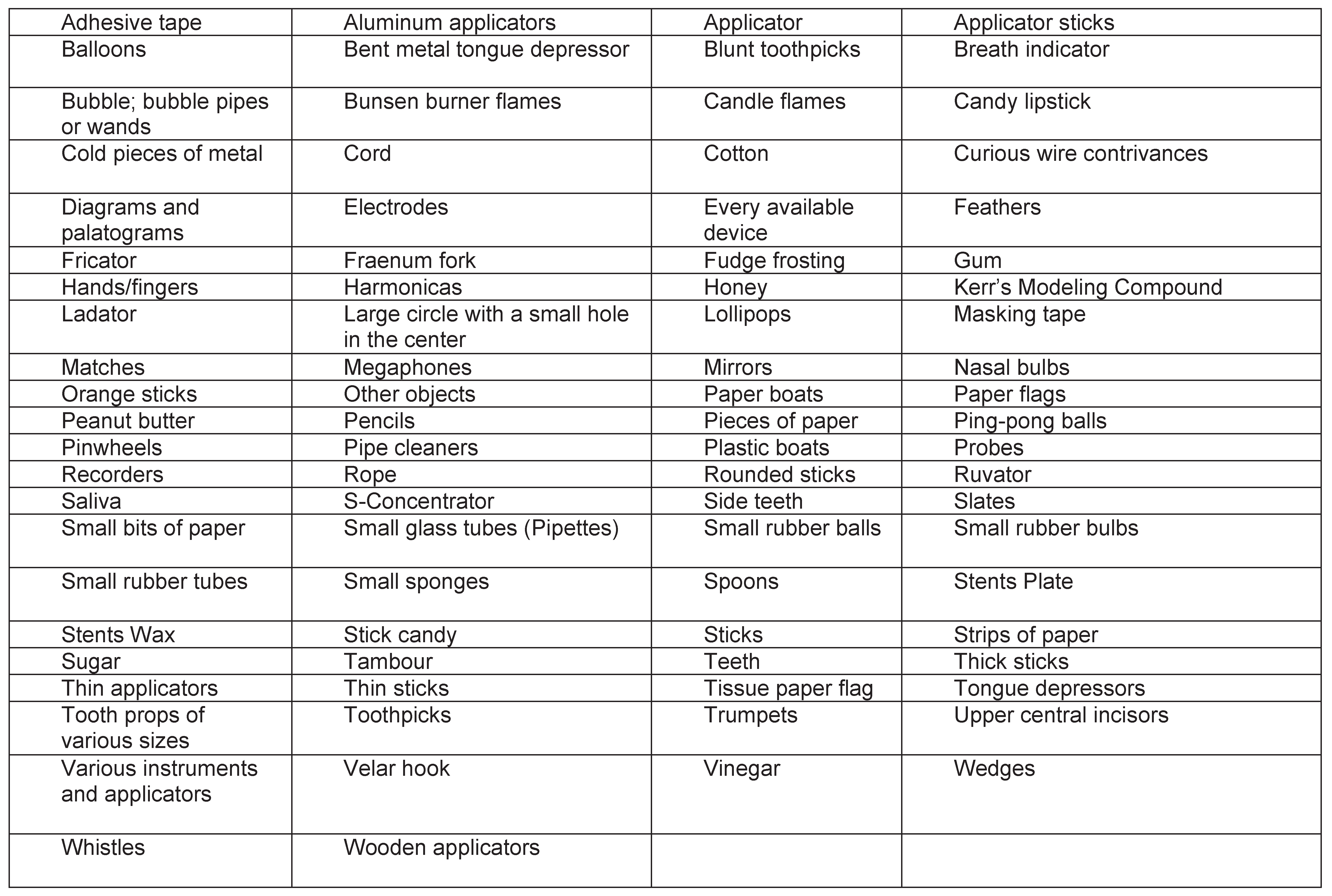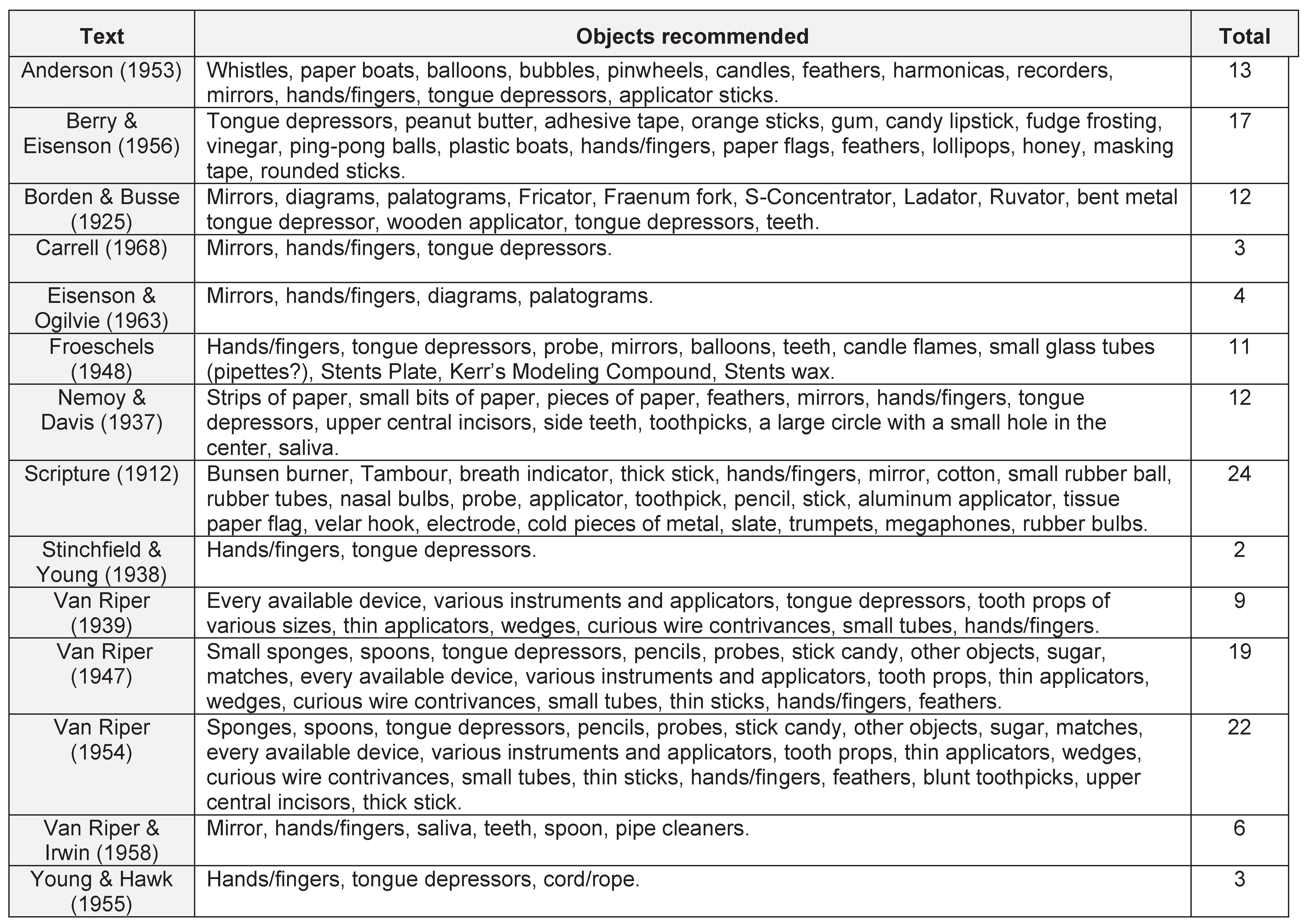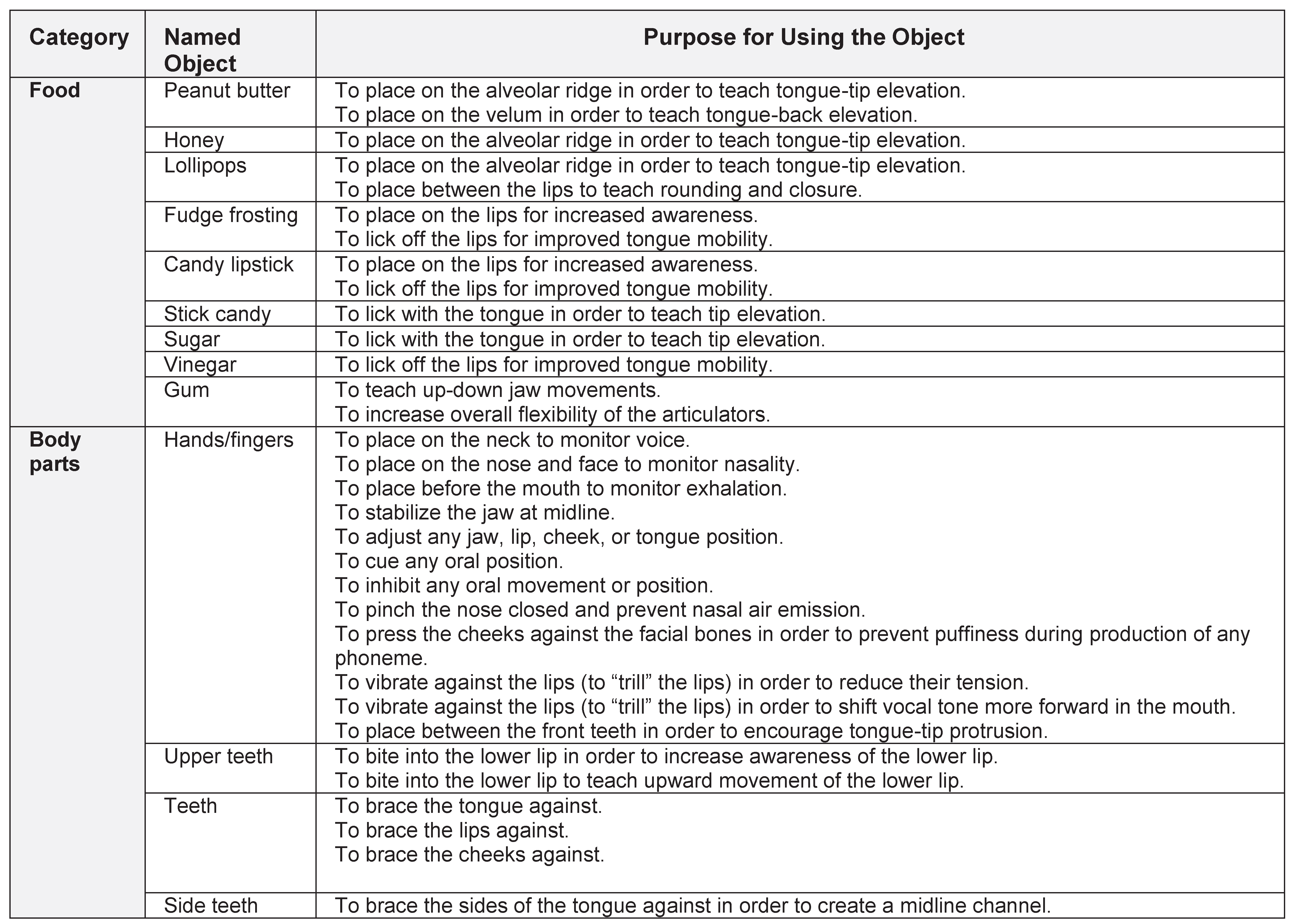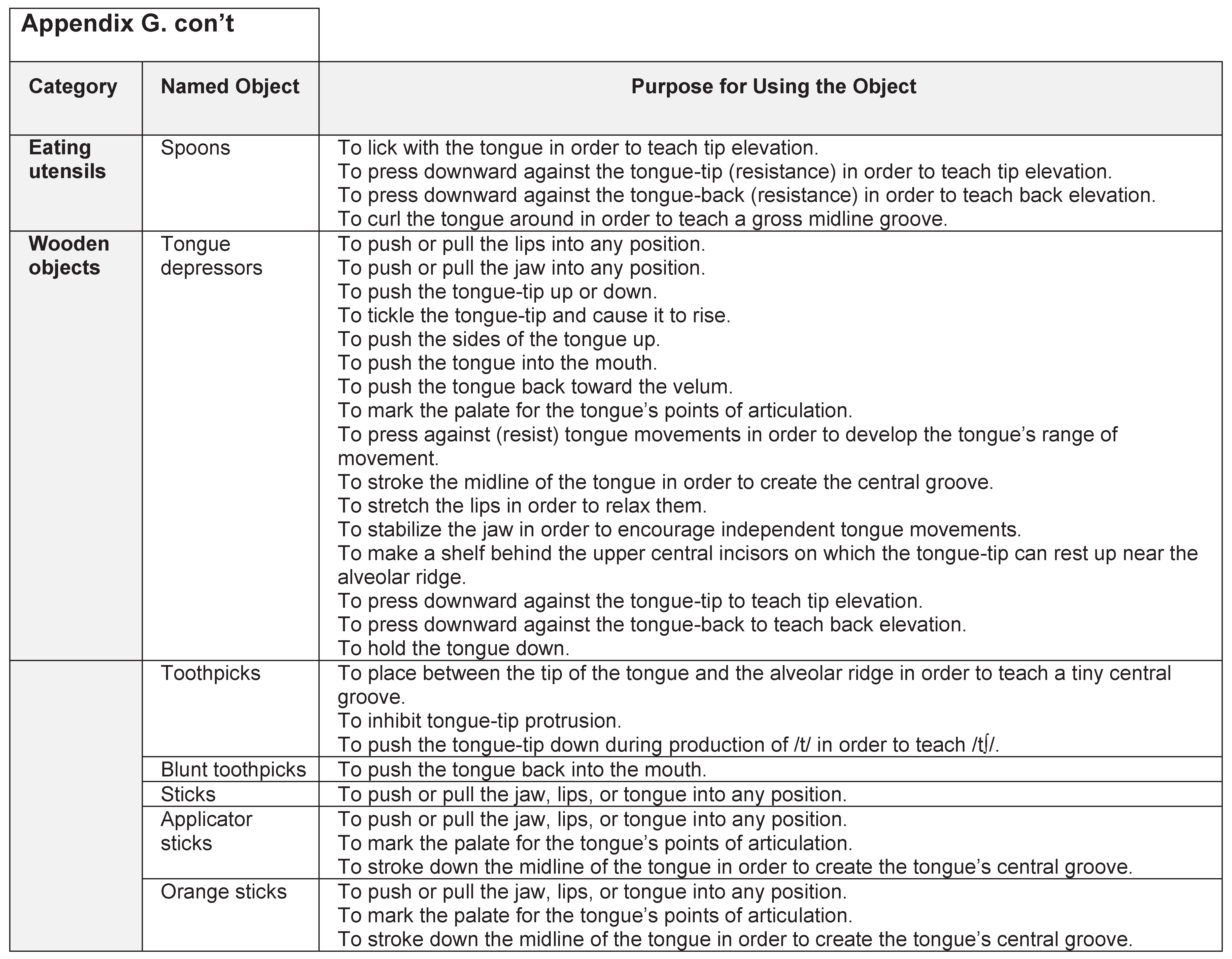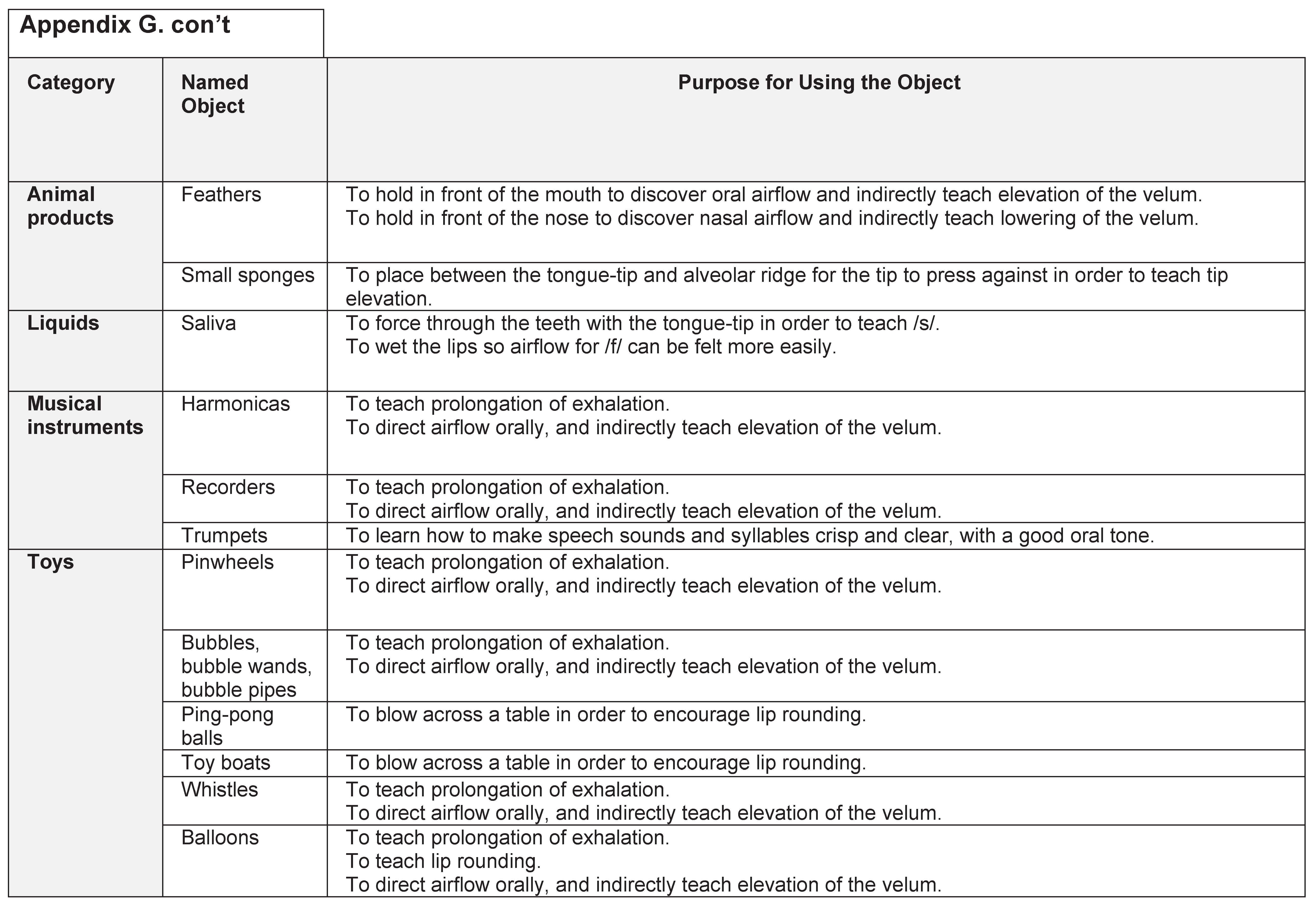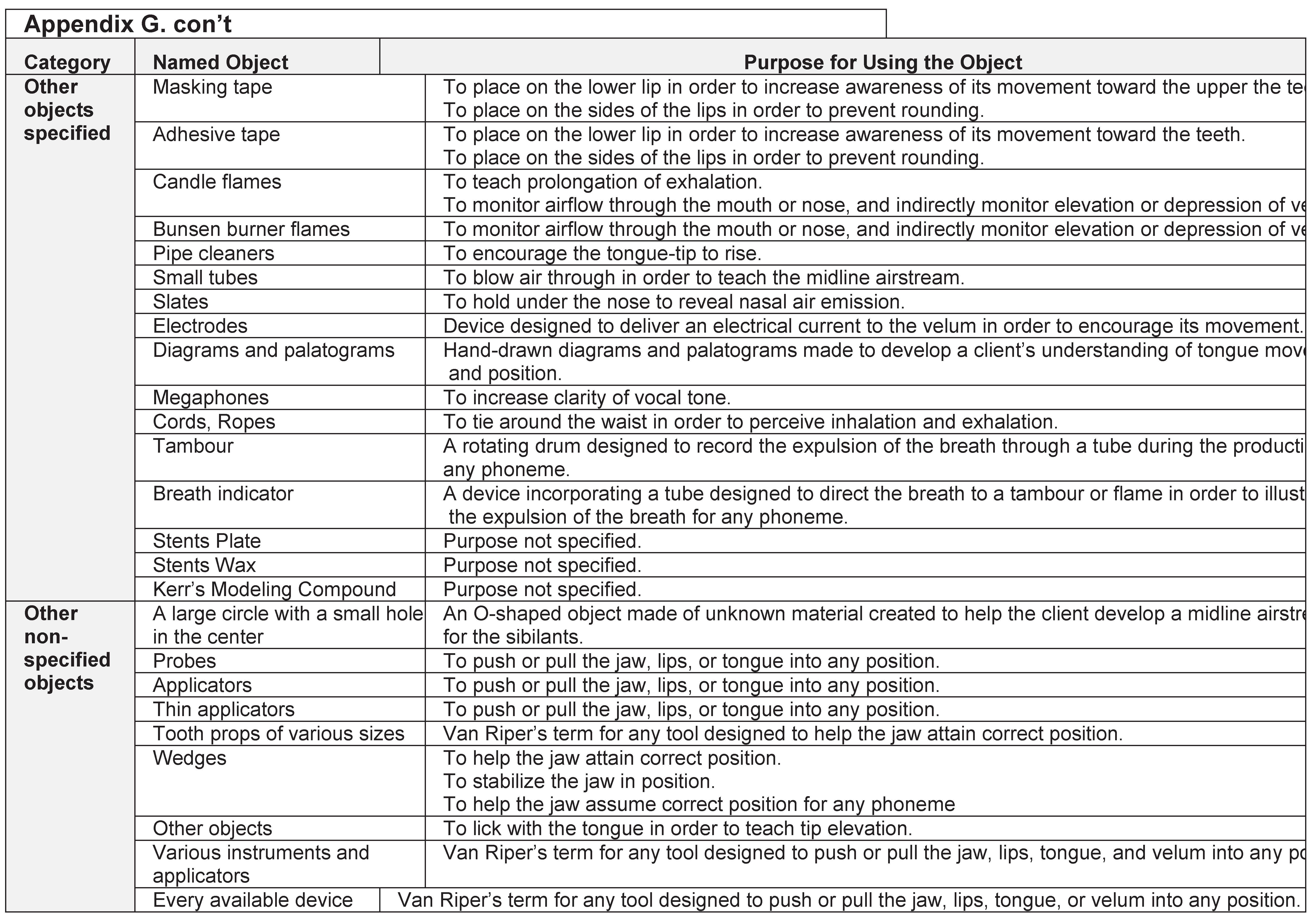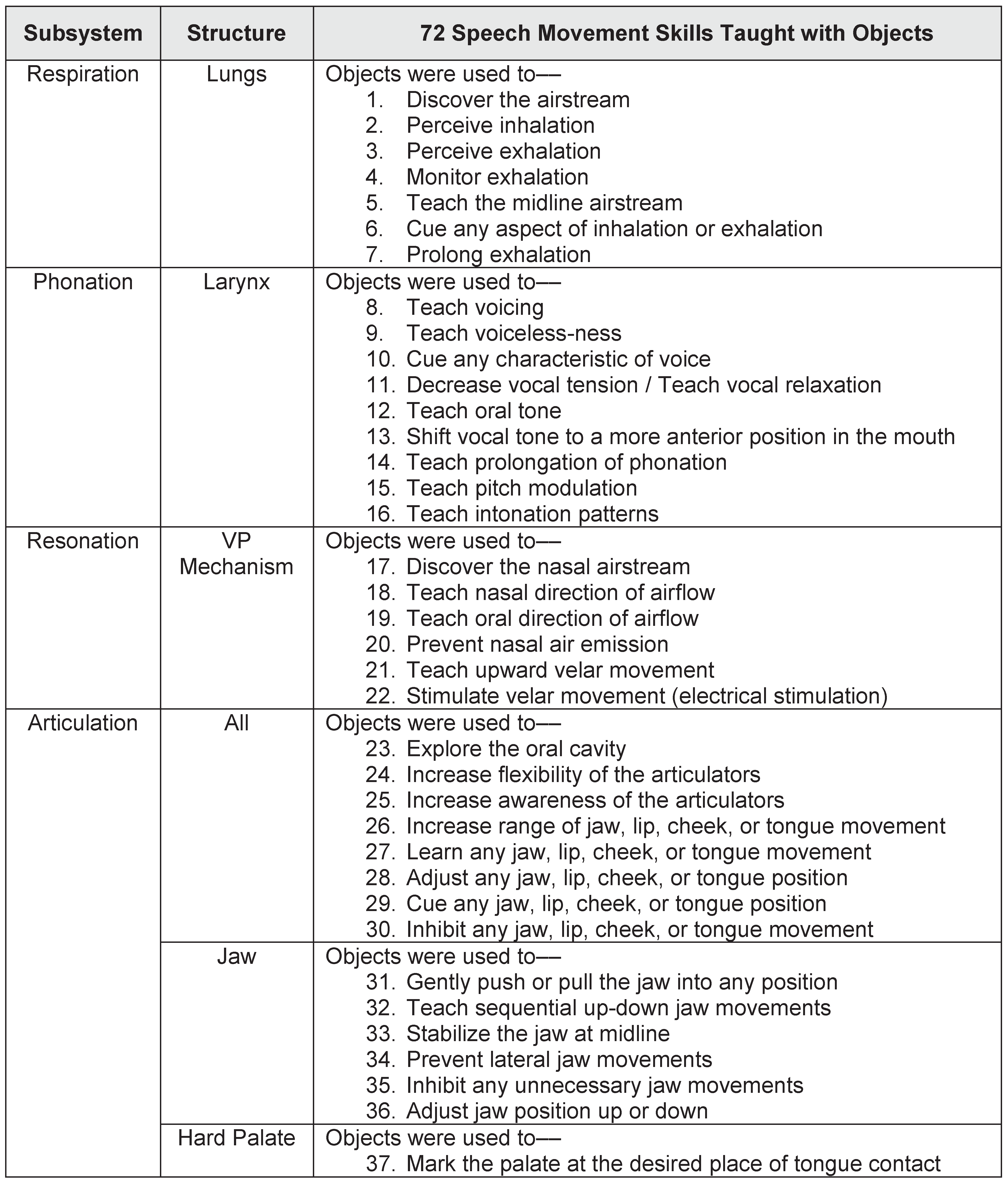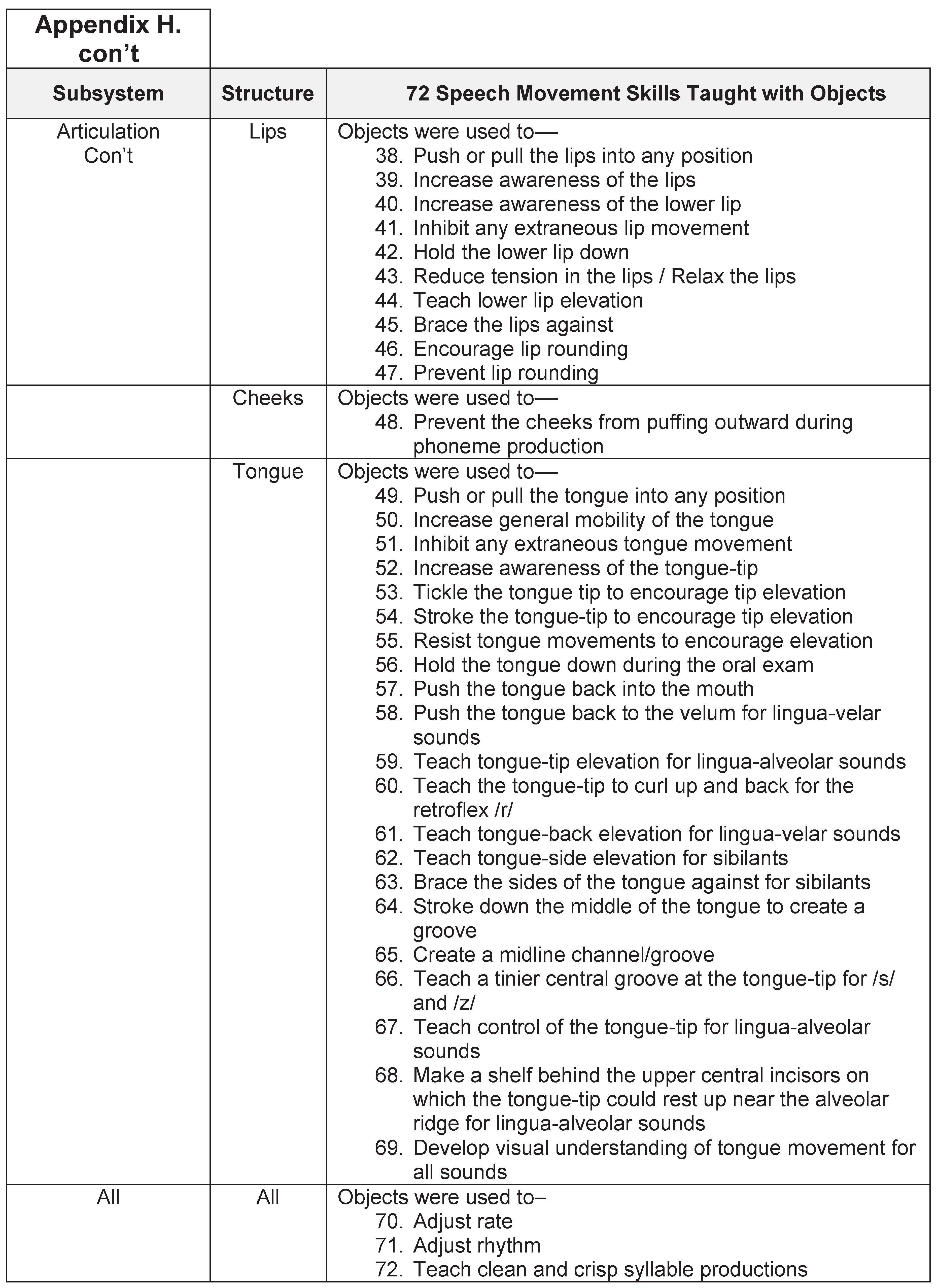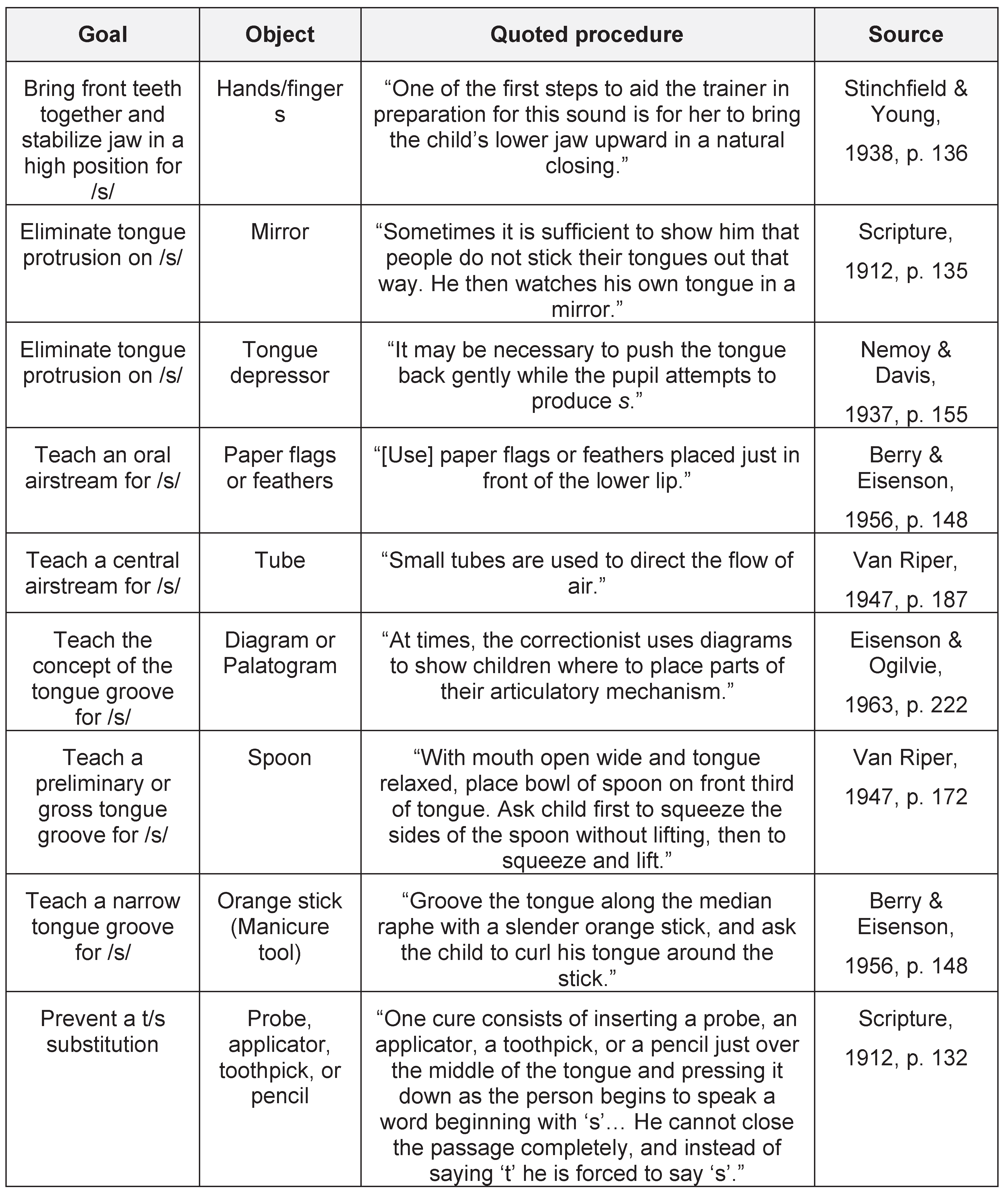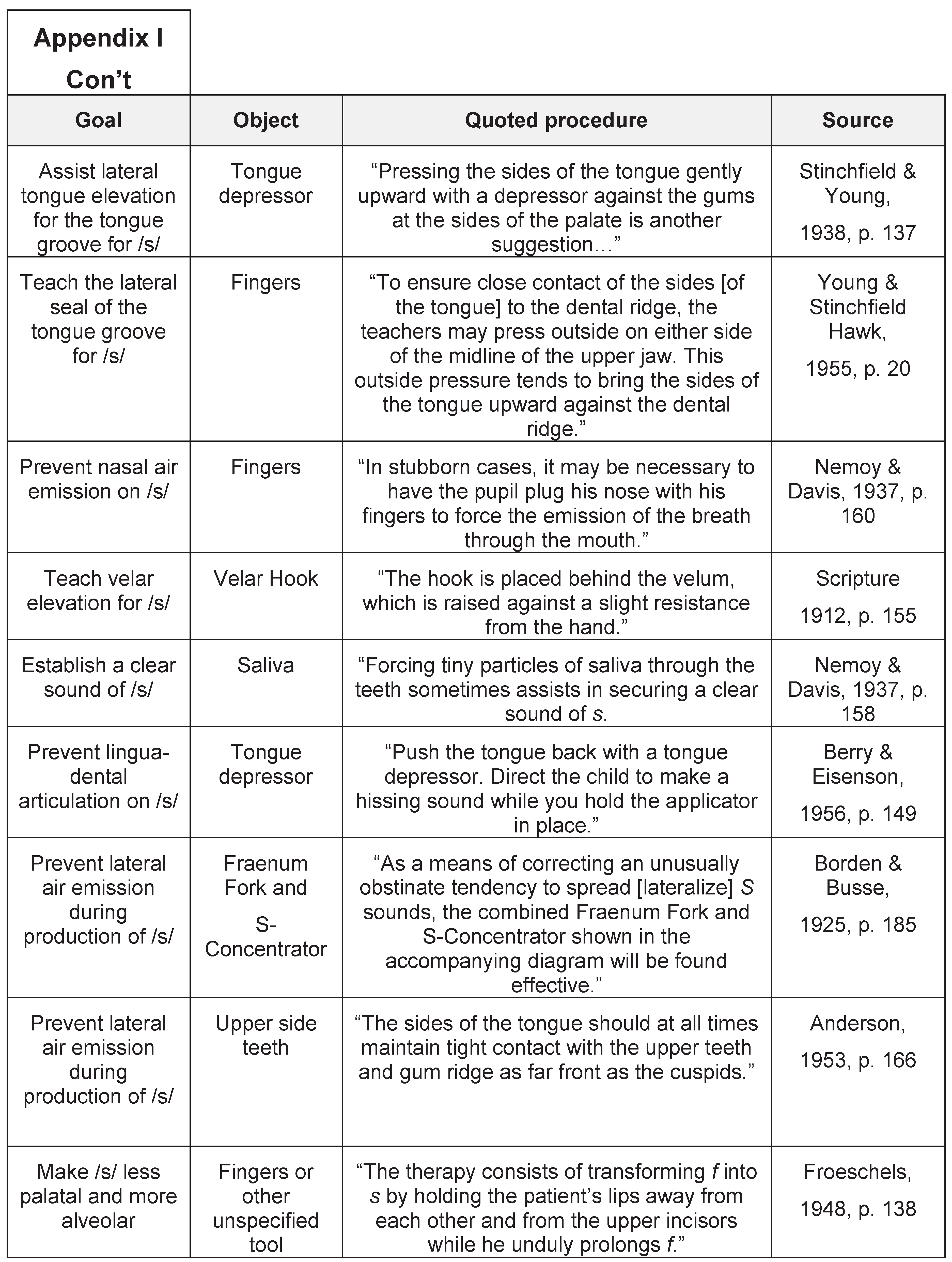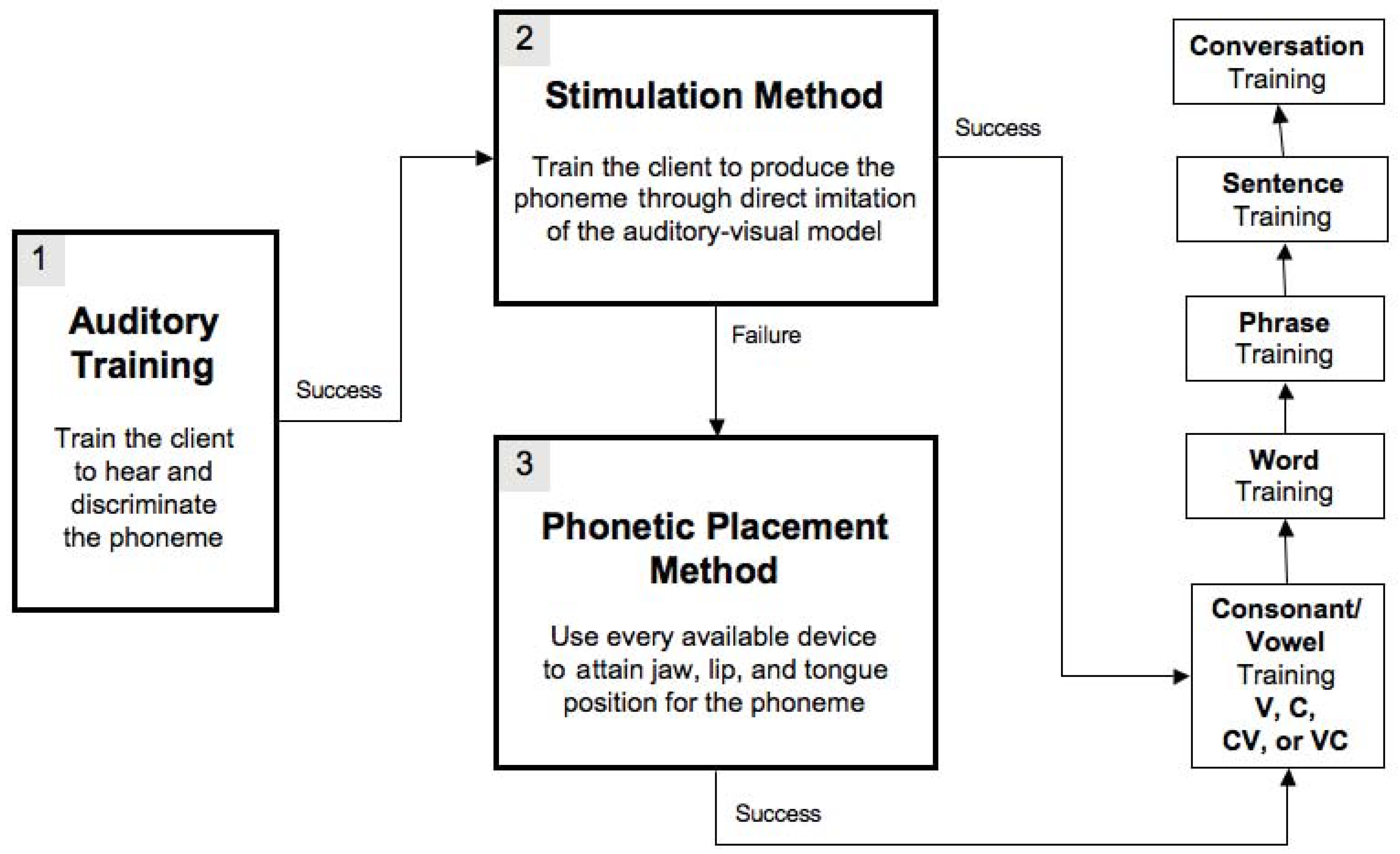BACKGROUND
Some speech-language pathologists (SLPs) have cautioned against the use of objects such as horns, whistles, bite blocks, and straws in articulation training (
Bowen, 2005;
Lof, 2008;
Lof & Watson, 2008;
Powell, 2008; Forest & Iuzzini, 2008; Muttiah, Georges, & Brackenbury, 2011). Activities that employ these types of tools have been bundled into categories called
nonspeech oral motor exercises (NSOME;
Lof & Watson, 2008) and
nonspeech oral motor treatments (NSOMT;
Lass & Pannbacker, 2008). Employing the term “nonspeech” suggests that using an object in articulation therapy is unrelated to classic processes of speech correction and therefore should be avoided. One writer even stated that it would be a progressive step if these types of activities were condemned (
Bowen, 2005). Some arguments against the use of objects in speech treatment have been:
- (1)
There is insufficient evidence to support the use of objects in articulation therapy.
- (2)
There has been no demonstrable relationship between so-called “nonspeech” activity and speech.
- (3)
Articulation improvement cannot be gained if therapists focus on the individual parts of phoneme productions instead of whole phonemes or syllables.
- (4)
Speech-language pathologists may be using objects indiscriminately in articulation therapy.
Despite objections such as these,
Lof and Watson (
2008) also demonstrated that the use of NSOME seems to be widespread in North America.
The central questions to be answered in this paper are:
How did Van Riper and other architects of traditional articulation therapy use objects in articulation therapy?
What was their rationale for using objects in articulation therapy?
What types of objects did they use?
For what purpose did they use these objects?
METHODS
Textbooks published between 1939 and 1968 were reviewed. 1939 was the year Van Riper published his first textbook (Van Riper, 1939), and he is widely considered to be the main architect of traditional articulation therapy. The final year,1968, was selected as the year that the first principal works about phonological concepts entered the English literature (
Chomsky & Halle, 1968;
Jacobson, 1968). Phonological theory facilitated a radical shift in the way speech-language pathologists analyze and treat speech impairment.
Ten textbooks were selected for review (
Appendix A). These books were chosen because they met the following criteria:
- (1)
They were used to train students studying the assessment and treatment of speech disorders.
- (2)
They were published between 1939 and 1968.
- (3)
Their titles contained the words speech, speech therapy, speech correction, speech disorders, articulation, articulation therapy, or articulation disorders.
Three other books published before 1939, and one from 1955, were added to this group because Van Riper consistently recommended them as resources for additional methods (
Appendix B). Therefore, a total of fourteen textbooks were reviewed. Altogether fifteen speech professionals authored these texts. Four of the writers served as Presidents of the American Speech-Language-Hearing Association (ASHA), and six received ASHA’s prestigious Honors of the Association (
Appendix C). Van Riper wrote four of the books under review.
Once the review of these fourteen books was completed, three of Van Riper’s later texts (Van Riper, 1978; Van Riper & Erickson, 1984, 1996) were surveyed for comparison to the earlier volumes used in the review. One letter Van Riper wrote in 1993 also was reviewed for comments he made about his early work in articulation therapy (Secord, et al, 2007, p. viii).
Each text was read, and findings were recorded on worksheets designed especially for this purpose (
Appendix D). Each object named as a tool to teach the movements or positions of phoneme production was added to the list. The page on which the object appeared was noted and its purposes were described. Objects also were classified according to the following types: Animal product (A), Body part (B), Cold object (C), Eating utensil (E), Food (F), Glass object (G), Heated object (H), Liquid (L), Metal object (M), Musical instrument (MI), Paper object (P), Plant-based object (PB), Rubber object (R), Toy (T), Wooden object (W), Other specified object (OS), and Other non-specified object (ONS).
RESULTS
A total of 86 different objects, or types of objects, were mentioned in the fourteen textbooks reviewed (
Appendix E). Careful scrutiny of
Appendix E reveals that many of these objects were regular household items such as spoons, toothpicks, lollipops, mirrors, tissue paper, and ping-pong balls. Several items were common medical/laboratory items such as nasal bulbs, pipettes, and tongue depressors. Some items appear to be alternate names for the same object. For example, the following terms were found: “applicator,” “applicator stick,” “thin applicator,” “wooden applicator,” “stick,” “thin stick,” “thick stick,” “rounded stick,” and “tongue depressor.” It is possible that all of these were terms for the tongue depressor, but the texts did not make that clear so these objects were listed separately. The reader also will notice objects identified by generic names such as “probes,” “wedges,” “tooth props of various sizes,” “other objects,” and “every available device.” There was no way to determine from the texts what these objects actually were, so they were listed exactly as named by the original authors. Van Riper referred to all of these tools as “various instruments and applicators.”
Additional study of
Appendix E reveals several objects that will be unfamiliar to the modern reader including: “Fricator,” “Fraenum Fork,” “Ladator,” “S-Concentrator,” and “Ruvinator.” These were specialized wire tools that were developed by
Borden and Busse (
1925) at the New York University Speech Clinic. Each tool was designed to teach a particular speech movement. The “Fricator” was designed to hold the tongue-tip down. The “Ladator” was designed to hold the lower lip down. The “Fraenum Fork” was designed to teach the tongue to groove for the sibilants. The “S-Concentrator” was designed to teach a smaller and tighter groove at the tongue-tip (a more “concentrated” groove). The “Ruvinator” was designed to push the tongue into a high back position for the lingua-velar phonemes. Van Riper referred to all of these objects as “curious wire contrivances.”
Other unfamiliar items also will be found in
Appendix E. The “Velar Hook” was a tool made out of “a rubber pen holder” (
Scripture, 1912, pp. 153-155). The object was placed in the mouth and hooked onto the back of the velum. The instructor then used the tool to exert slight forward pressure against the soft palate. The client worked to lift his soft palate up and back against this resistance to close off the nasal port. Froeschels (1948) named three other unusual objects: “Kerr’s Modeling Compound,” “Stents Wax,” and “Stents Plate.” These products are used today for making dental impressions and models, but the purposes for using them in articulation therapy were not described in Froeschels’ text.
Appendix E also reveals that the hands and fingers were considered “objects” in this review. Manipulation of oral structures with the hands and fingers was recommended by all but one of the authors, and they were the main tools recommended in the two books written about the motokinesthetic method (
Stinchfield & Young, 1938;
Young & Hawk, 1955). The hands and fingers were treated as one single object and recorded as “hands/fingers” because authors often did not differentiate between them. Some authors specified a thumb or finger to be used, but generally the hands and fingers were treated generically. Van Riper used his hands and fingers in various ways to stimulate oral positions for phoneme productions; however, with Irwin he hinted that the motokinesthetic method probably relied
too heavily on the hands and fingers (
Van Riper & Irwin, 1958). Van Riper and Irwin preferred to have clients use their own hands and fingers as feedback mechanisms to supplement the auditory and visual sensations they experienced while learning phonemes.
The authors also referred to the teeth as “objects” relative to jaw, lip, cheek, and tongue manipulation. The upper central incisors were used to stimulate lower lip elevation, and the side teeth were used to stimulate lateral tongue elevation. The side teeth also were used as objects against which the cheeks could brace.
The 86 objects were organized in Appenix F according to the authors who discussed them.
Appendix F reveals that all fifteen authors employed objects in the process of articulation therapy. Some authors recommended only a few objects while others named a wide variety. The number of objects mentioned and/or discussed by each author ranged from 2 to 24. Authors who named the most items included Van Riper (1954) who named 22 and Scripture (1912) who named 24. Authors who described how to employ a small number of objects relied upon wooden objects (tongue depressors and other “sticks”), the hands and fingers, household mirrors, and hand-drawn diagrams and palatograms as their main tools of articulation training. Some writers described how they utilized objects in great detail (e.g.,
Nemoy & Davis, 1937;
Young & Hawk, 1955). Other authors described the use of objects only in passing (e.g.,
Eisenson & Ogilvie, 1963;
Carrell, 1968).
Van Riper termed the process of using objects in articulation training the phonetic placement method. He wrote: “For centuries, speech correctionists have used diagrams, applicators, and instruments to ensure appropriate tongue, jaw, and lip placement… [These] phonetic placement methods are indispensable tools in the speech correctionist's kit… Every available device should be used to make the student understand clearly what positions of tongue, jaw, and lips are to be assumed” (Van Riper, 1954, pp. 236-8).
Appendix G contains a summary of the stated purposes served by the 86 objects by category. A quick scan of this appendix reveals that tongue depressors and other wooden objects were used for far more purposes than any other single item. The hands and fingers were the next most widely used items. The reader also can verify that while a few objects were used for only one purpose, most objects were used for multiple purposes. The overall purpose of using objects was “to manipulate the tongue, lips, and jaw [and] to touch mouth surfaces for showing tongue placement” (
Carrell, 1968, p. 99).
Appendix H lists the 86 objects according to the goal they served, organized by subsystem and structure. The appendix reveals that the objects were used for a variety of goals, from attaining lip rounding for /w/ to gaining tongue-back elevation for /k/ and /g/. No objects were used to teach whole phonemes; therefore, there was no one tool for /p/, or /l/, or /k/, and so forth. Instead, it was found that objects were used to teach component speech movements, and the objects varied according to the targeted goal. Thus one tool might be used to teach the velum to rise while another was used to encourage the tongue to groove. Objects were used to facilitate changes in each of the four primary speech subsystems: respiration, phonation, resonation, and articulation. These textbooks collectively described methods for using objects to teach a total of 72 distinct movement skills, or types of movements, provided in
Appendix H and summarized here:
Jaw: Objects were used to teach dissociation, grading, and direction of the lower jaw’s vertical (up and down) movements. Objects were used to stabilize the lower jaw’s vertical position in order to achieve appropriate amounts of mouth openness and closure (i.e., grading). Objects were used to guide the jaw left, right, forward, or back in order to achieve a midline position. Objects also were used to inhibit unnecessary jaw movements.
Lips: Objects were used to teach bilabial and labio-dental contact, as well as lip rounding and retracting. Objects also were used to inhibit unnecessary lip movements and to reduce tension in the lips both before and during phoneme productions.
Cheeks: Objects, especially the hands and fingers, were used to hold the cheeks in position against the lateral dentition (side teeth) during phoneme production.
Tongue: Objects were used to stimulate general gross tongue movement as well as to prevent unnecessary tongue movement. Objects were used to elevate the tongue-tip to the maxillary anterior alveolar ridge. They also were used to hold the tongue-tip against the alveolar ridge, to prevent the tongue-tip from reaching the alveolar ridge, and to tease the tongue-tip away from the alveolar ridge. Objects were used to elevate the tongue-back to the soft palate as well as to elevate the sides of the tongue to the upper side teeth and gums. Objects were used to create both wide and narrow central grooves in the tongue, as well as to create a tiny central groove at the tongue-tip. Objects were used to teach the tongue-tip to curl up and back for the retroflex /r/. Objects also were used to push the tongue back into the mouth when it habitually postured in an anterior or interdental position.
Palate: Objects were used to stimulate specific locations on the palate at points where the tongue was to make contact. For example, the anterior portion of the alveolar ridge was stroked with an object at the point Van Riper called “the spot” in order to teach lingua-alveolar contact (Van Riper, 1947, p. 191).
Respiration: Objects were placed on and around the chest, and in front of the mouth and nose, in order to teach clients to become aware of their own patterns of inhalation and exhalation. Objects also were used to teach prolongation of exhalation. Small objects and tubes were used to teach the discrete differences in airflow for each of the fricatives and affricates.
Phonation: Objects, especially the hands and fingers, were placed on the face and throat to educate clients about several facets of voice. They were used to teach clients how to produce phonemes with and without voicing as well as how to produce voiced sounds and words without tension.
Nasal Resonance/Velum: Objects, especially the hands and fingers, were placed on the face to help clients become aware of, to modify, and to control their own oral and nasal resonance. Paper and tissue “flags” were held in front of the mouth and nose to help clients control the direction of oral and nasal airflow. Objects also were placed directly against the velum to teach it to raise and lower.
Prosody/Fluency: Objects, especially megaphones and wind instruments, were mentioned on occasion as aids in the teaching of certain aspects of prosody and fluency including pitch, stress, loudness, rate, and intonation modulation.
Review of the textbooks revealed that collectively the authors had devised activities using objects to teach every component movement necessary for production of all Standard North American English consonants, vowels, and diphthongs.
Nemoy and Davis (
1937) were the only authors to discuss a variety of specific object techniques for every consonant. Scripture (1912) described how to use objects to teach each consonant except /h/.
Young and Hawk (
1955) were the only authors to describe how to apply these ideas specifically for every consonant as well as for every vowel. The other writers concentrated on methods to address movements for only the more problematic consonants, including /l/, /r/, /k/, /g/, and the fricatives/affricates. An example of selected procedures to teach the movements and positioning required for /s/ from the texts are presented in
Appendix I.
In regard to the logistics of using objects in articulation therapy, each of these authors recommended that objects should be employed
after a client has failed to produce a correct phoneme from an auditory-visual model and from direct verbal instruction. In each of his texts, Van Riper claimed that the training of any phoneme begins with stimulating the auditory system (
auditory training), and then proceeds to providing an auditory-visual model for the client to imitate (
stimulation method). He contended that if auditory training and the therapist’s model alone did not teach the client to produce the correct phoneme right away, then other methods needed to be employed. These other methods included the phonetic placement method and those objects employed in its application (
Figure 1).
DISCUSSION
Many points of discussion resulted from this textbook review. Objects were a regular part of traditional articulation therapy according to Van Riper and the writers of the fourteen textbooks reviewed, and to suggest otherwise is historically inaccurate. Van Riper called this the phonetic placement method, and he himself used a wide variety of objects for this purpose. The main purpose of using an object was to teach dissociation, direction, and grading of oral movements for phoneme position/placement. Authors of these historical texts used objects to assist independent movements when a client could not accomplish them without assistance.
Van Riper taught that objects were to be used only after a client had failed to imitate an auditory-visual model of the target phoneme. In other words, he posited that one should not begin teaching a phoneme with an object. Van Riper explained that phoneme training begins with auditory training. Once the client is aware of the phoneme, can identify it, and can discriminate it from other similar phonemes, the actual process of teaching production begins with modeling the phoneme for the client to imitate––the stimulation method. However, according to Van Riper, if auditory training and a therapist’s auditory-visual model do not stimulate a better production of the target phoneme with accurate movement and positioning right away, other methods, including the phonetic placement method and the objects it employs, should be used to teach place, manner, and voicing.
None of the writers in the textbook reviews suggested that an object alone would bring about phoneme emergence or correction. Objects were to be used to stimulate appropriate dissociation, grading, or direction of movement, and then these movements were to be used to teach target phonemes. This is a two-step process that Van Riper described as follows: “The therapist…is attempting to give [the client] the appropriate location and formation. As soon as this has been achieved, the therapist stimulates [the client] with the correct sound” (Van Riper, 1954, p. 147).
A misunderstanding of the basic phonetic placement process may be causing some of the recent concern among speech-language pathologists about using objects in articulation therapy. Some academics and clinicians who condemn the use of objects or tools (including the hands and fingers) in speech therapy, by calling these activities NSOME/NSOMT, have implied that therapists are attempting to use objects alone to cause phonemes to emerge or correct. According to Powell for example, “Party horns… blow ticklers… bubbles… straws… Items such as these are being used by speech-language pathologists (SLPs) across America to treat a wide range of communication disorders… they employ nonspeech tasks as an indirect means of modifying speech production” (
Powell, 2008, p. 374). If it is true that SLPs are using objects alone to correct phonemes, this runs counter to the historic use of objects as presented by the authors reviewed.
One of the current arguments against using objects is that there has been no demonstrable relationship between speech and “nonspeech” activity (e.g., Wilson, Green, Yunusova, & Moore, 2008). Some authors are warning that it is inappropriate to have clients chew gum to get the jaw to move up and down, to bite on a bite block to stabilize the jaw at various heights, to blow whistles to learn lip rounding, or to press the tongue-tip against a spoon to learn tongue-tip elevation. Those clinicians who disapprove of such measures fail to consider the sample of clients with oral sensory-motor delays/deficiencies who may require help in producing appropriate jaw, lip, tongue, or velar movements as preparatory skill development before specific phoneme training is possible. Van Riper called these clients “clumsy-tongued individuals” and “the slow of tongue” (Van Riper, 1947, p. 132). The need to develop some basic movement skills in order to control structures associated with speech has merit. In Van Riper’s words: “In modern speech correction, the emphasis on tongue exercises has almost disappeared. Yet for certain of the clumsy tongued individuals with whom we work, modern forms of these exercises are very valuable” (p. 132).
Van Riper’s texts clearly point to and recommend that speech-language pathologists engage in these routines in order to attain preliminary movement approximations for speech. He wrote: “Whenever possible the articulatory exercises given should proceed out of the movements used in the biological functions” (Van Riper, 1939, p. 242). Van Riper even recommended the use of “non-speech” activity itself when working with young children: “With smaller children it is often necessary to begin by training them in imitation of non-speech movements” (
Van Riper & Irwin, 1958, p. 144). Modern SLPs are trying to reconcile these basic Van Riper methods with recent cautions about the use of objects or tools in so-called “non-speech” activity. Much confusion about why and how to use objects in articulation therapy appears to be the result.
It also has been argued that articulation improvement cannot be achieved if therapists focus on the individual parts of phonemes instead of the whole phoneme in a syllable or word (e.g.,
Bowen, 2005;
Bunton, 2008;
Forest, 2002;
Lof, 2003; Kahmi, 2008). For example, when teaching /k/, the warning is to leave jaw, lip, and tongue control alone, and just teach /k/ within the language context. This procedure ignores clients with oral sensory-motor issues who simply cannot elevate the back of the tongue on demand. How long must a speech-language pathologist model /k/ in syllables or words with no success before he or she decides to do something directly to help the client lift the back of the tongue? Van Riper and the other authors reviewed suggested that this help should be given right away. According to each of the reviewed textbooks, word drilling often is not enough to correct the articulation of phonemes. The early authors of articulation texts in this review concluded that therapy should switch quickly to the individual phoneme (or syllable) when failure occurs, and further assistance on place, manner, and voice features should be given right away. Objects may be used to teach these features if necessary. This recommendation represents basic articulation therapy as taught by the authors under discussion.
The reader will note that some of these authors utilized unsanitary and potentially harmful or dangerous object activities that are not compatible with current safety requirements. For example,
Nemoy and Davis (
1937) recommended placing small bits of paper on the back of the tongue to teach posterior tongue elevation, and the aspiration of such objects represents a risk that was not identified.
Some may claim that Van Riper modified his views about the use of objects in articulation therapy later in life. A review of his final thoughts on the subject may shed light on this conjecture. Examination of the last edition of Van Riper’s textbook revealed that he had continued discussing these methods as a regular part of therapy (Van Riper, 1978). It is therefore apparent that Van Riper advocated the use of objects in articulation therapy for at least four decades, from 1939 through 1978.
Beginning in 1984, however, Van Riper collaborated with a colleague (Erickson) in writing another basic text, An Introduction to Speech Pathology and Audiology (Van Riper & Erickson, 1984). In the introduction, Van Riper noted that the very purpose of the text had changed from being a collection of methods for speech-language pathologists, to a general introductory text for undergraduate speech and other students. The section of the text on articulation was highly influenced by this transformation. The authors made more generalized statements about articulation therapy, they introduced phonological theory, and they dropped almost all of Van Riper’s specific phonetic placement methods along with the discussion of the objects he used to accomplish them. This seems to have become the model for many articulation/phonology textbooks published since that time.
Modern textbooks on articulation and phonology continue to acknowledge the phonetic placement method as one viable option in articulation therapy, but the many details of how to utilize objects generally are not included. As examples,
Bernthal and Bankson (
2004),
Bauman-Waengler (
2004), and
Pena-Brooks and Hegde (
2000) present general statements about the phonetic placement method, offering a few sample methods as illustrations. Likewise these texts acknowledge the motokinesthetic method (
Stinchfield & Young, 1938;
Young & Hawk, 1955), but the great details of the ways in which these therapists used their hands and fingers to teach positioning of the speech structures are absent. The reduction of phonetic placement techniques and motokinesthetic methods into simplified paragraph descriptions has left generations of therapists lacking specific knowledge about the vast array of objects, including the hands and fingers, which were used to influence oral movement in Van Riper’s time. Perhaps the misunderstanding and misuse of objects today has been the inevitable result.
Phonetic placement methods and the objects used to accomplish them endured into the 1980s in a few books including
Vaughn and Clark (
1979),
Bosley (
1981) and
Hanson (
1983). In the 21
st century, the details of object use for phonetic placement and motokinesthetics have survived and thrived by shifting them away from main introductory textbooks designed for students, and into practical instructional manuals designed for working professionals.
A number of modern guidebooks contain procedures for using objects in the process of speech movement instruction. These include
Bahr (
2001),
Bleile (
2006),
Gilbert and Swiney (
2007),
Marshalla (
2004,
2007),
Rosenfeld-Johnson (
2001,
2005), and Secord et al (2007). Although the term “oral motor” (simply meaning “mouth movement”) has been attached to some of them, many of the techniques contained in these manuals are updated versions of what Van Riper called “the old traditional methods.” As an example, Van Riper (1947) used a pencil to teach lip rounding, and he called it a
phonetic placement method, while
Gilbert and Swiney (
2007) used a gummy worm to teach lip rounding, and they called it an
oral motor technique. The goal and procedures are the same, but the tool has been modernized and the vocabulary updated.
Phonetic placement techniques and their objects are employed when a client simply cannot learn a specific speech movement in any other way. Secord, a protégé of Van Riper, wrote that one uses these and other methods “when the client cannot produce a target sound at all” (Secord, et al., 2007, p. 3). He continued: “In a manner of speaking, the clinician needs to ‘roll up her sleeves’ and actually teach the client how to say the target sound” (p. 3). This is a process of teaching the mechanics of sound production (phonetics), not the use of a phoneme within a language (phonology). Professional speech-language pathologists today welcome these ideas in manuals and continuing education programs because the rich assortment of phonetic placement techniques that formerly appeared in articulation therapy textbooks are no longer included in modern texts.
CONCLUSIONS AND IMPLICATIONS FOR THERAPY
This textbook review strongly suggests that objects can and should continue to be used to teach speech movements in articulation therapy when the phonetic placement method is employed. To claim that this is a new idea, to ban the use of objects in articulation therapy, or to assert that this is “non-speech” activity ignores the fact that practicing clinicians have been using objects continuously in speech training in the United States since at least 1912. Using objects to teach speech movement is exactly what Van Riper and other traditional therapists often did when a client could not produce a target phoneme by imitating it. Speech-language pathology students would benefit from being taught to appreciate the historic value served by objects in speech movement training instead of being taught to ignore or condemn this process. Seasoned professionals would benefit from considering how these ideas might apply to clients who do not respond well to model-and-imitate methods of phoneme stimulation.
The traditional therapists of these textbooks used tongue depressors and other “sticks” more than any other tools in articulation therapy. SLPs today continue to use tongue depressors, but some problems exist. The present author has found that tongue depressors are too wide, too thick or too thin, the wrong shape, and simply too clumsy for many of the delicate oral adjustments necessary in articulation training. Additionally, wood can have an unpleasant taste and feel in the mouth even when it is flavored, and an adult-sized tongue depressor can splinter fairly easily when a client bites down hard on its thin edge. Alternatives to the tongue depressor are welcome for these reasons. For example, a modern flexible plastic dental pick often can be slipped between the upper central incisors and placed so that it sits between the tongue-tip and the alveolar ridge. This tiny tool allows for more direct instruction about tongue-tip placement for /s/, /z/ and the other lingua-alveolar phonemes than does the much larger tongue depressor.
SLPs also find that they cannot use their hands and fingers as easily as the therapists in this review because of new restrictions regarding sanitary procedures. SLPs often do not have sinks for proper hand sanitation in their therapy spaces, they may not be provided with gloves, and they may have clients who do not respond well to gloves or commercially available hand sanitizers. SLPs in the schools often work in groups and cannot sanitize their hands for every student simultaneously. Therapists in many environments find they cannot manipulate the papers, toys, and games of therapy while keeping their hands sanitized. They also cannot touch clients with the hands when working via on-line video services. Some SLPs work for employers who prohibit them, for legal reasons, from touching clients with the hands and fingers. An obvious solution to each of these situations is to employ a variety of sanitized objects the therapist can use or the client can use on himself.
Van Riper wrote that “every available device” should be used for phonetic placement. Speech-language pathologists who employ phonetic placement techniques today have a much wider range of tools from which to choose due largely to the invention of synthetic materials. For example, Van Riper may have used matches, pencils, toothpicks, and sticks to adjust jaw position, but a modern therapist can use a set of sanitary and professionally designed bite blocks. Many appropriate objects are being used today for phonetic placement:
Inexpensive household items: Including plastic straws, tubes, swizzle sticks, spoons, and eyedroppers. Metal spoons can be used as well.
Inexpensive items designed to improve oral hygiene: Including toothbrushes, toothettes, tongue scrapers, dental picks, dental floss, and dental floss handles.
Inexpensive toys: Including plastic horns, whistles, bubble wands, kazoos, and harmonicas.
Professionally designed oral/nasal tools: For example, the Lip Retractor, Z-Vibe, LifteR, Oral Probe, Lip Gym, Nasal Clamp, ChewyTube, Maroon Spoon, Jaw Grading Bite Blocks, and Progressive Jaw Closure Tubes.
Safe and sanitary tapes: Including latex-free and nonabrasive Kinesio Tape.
Objects are used when auditory bombardment, modeling, phonological awareness activities, reading programs, minimal pairs, and other linguistic and cognitive means are not enough to teach correct phoneme production. Phonetic placement techniques are employed as a last resort when a client needs to learn the specific movements of place, manner, voice, and resonance for particular phonemes, and there is nothing “nonspeech” about that. Nor is there anything new about it. Using objects is one of the traditional ways to teach speech movements in articulation therapy.
NEED FOR RESEARCH
Most of the activities utilizing objects that are recommended by the textbook writers of this review have not been tested using modern tools or research methodologies. Theoretical and opinion pieces on whether objects should or should not be used in treatment provide no evidence that these practices are ineffective. While this literature review does not prove that they are effective, the longevity and persistent presence of these methods over the past century, as demonstrated in this article, suggests that these methods have clinical value and warrant further investigation.
Some research on the use of objects for training phonetic placement has been initiated. The electropalatometer is being used to assess and guide tongue placement for sound production today (e.g.,
McLeod & Singh, 2009;
Gibbon, 1999; Dagenais, Critz-Crosby & Adams,1994;
Fletcher, 1992). An appliance for training /r/ was shown to have been effective when combined with auditory stimulation (Clark, Schwarz & Blakely, 1993). Research on SpeechBuddies suggests that tactile biofeedback on tongue position for /r/, /l/, /s/, /∫/, and /t∫/ reduces treatment time in some clients (
Rogers, 2010;
Rogers & Galgano, 2011). These projects are a beginning, but they address tongue movements only and some of this equipment is beyond a typical therapy budget. Therapists need research on the traditional roles that simple inexpensive objects have played and continue to play in learning all the speech movements of respiration, phonation, resonation, and articulation advocated by Van Riper and these other traditional writers. Ultrasound, magnetic resonance imaging, and even film or videotape could demonstrate these changes. The question to be asked is whether or not the object made learning correct movement and position for target phonemes easier, faster, or more efficient.
SUMMARY
A review of fourteen selected textbooks written in the first half of the 20th century revealed that traditional therapists considered it standard practice to use objects when teaching dissociation, grading, direction, and positioning of the articulators for phoneme production. To call these activities “non-speech” methods seems to misrepresent the historic purpose objects have served in articulation therapy. Van Riper recommended that every device available should be used to help clients learn specific speech movements when imitation of an auditory-visual model of a phoneme proved unsuccessful. He used the term phonetic placement method to describe this process. Speech-language pathologists who are implementing basic Van Riper routines continue to use objects to teach phonetic placement. Student clinicians need to be taught to appreciate the role objects have played in articulation therapy throughout the past century. Professionals need to consider how the implementation of such activities might help clients who do not respond well to simple model-and-imitate phoneme teaching routines. Empirical research on the effectiveness of using objects to teach oral movement for phoneme production is needed
